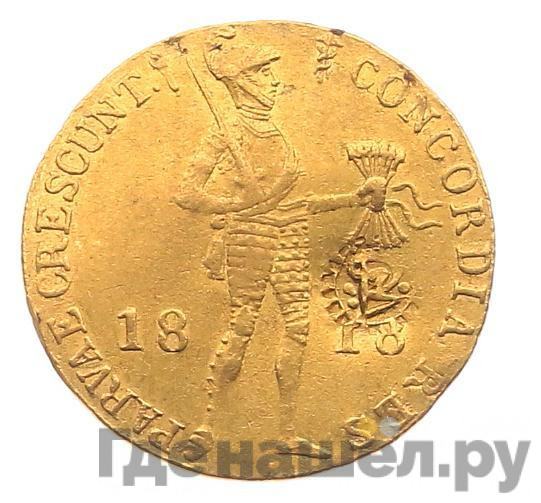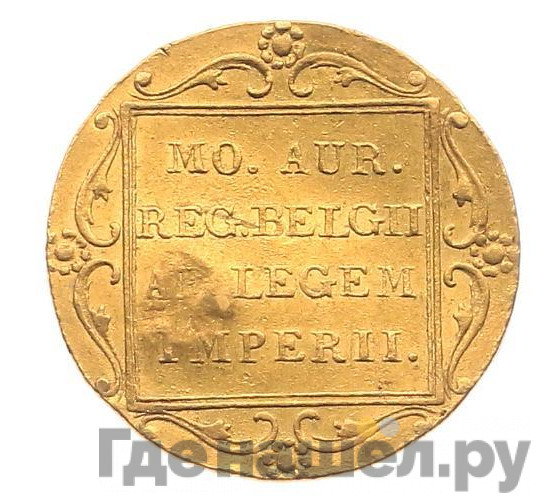Heritage Auctions Europe Coin Auction November 2019 - Session 1 Лот №129


Аукцион: Heritage Auctions Europe Coin Auction November 2019 - Session 1
Лот: 129
Завершен: 12.11.2019
| Стартовая цена: |
35 243 RUB
500 EUR |
Koninkrijk NL Willem I (1815-1840) - AV Ducat 1818, Utrecht-type (Sch.205), minted in St. Petersburg (Russia), for trade with Central Asia and India, countermarked with the Persian word ‘ra’ij’ (which means ‘current’), countermark within a toothed border, applied by the contemporary Durrani rulers of Afghanistan - Gold 3.46 gram - host coin good VF, c/m a.XF, this variety of the ‘ra’ij’ countermark with the toothed border has not been published and, with the only one other so far traced specimen in the NNC, of utmost rarity The countermark ‘ra’ij’ appears frequently on silver rupees of the Durrani dynasty, but is rarely found on gold coins and almost exclusively observed on the ducats dated 1818. The National Numismatic Collection (NNC) has two different specimen of the 1818 ducat with the ‘ra’ij’ countermark. The first example with the text within a toothed border is identical to the above specimen (provenance: Christie's Amsterdam (1988) - The Joop Berkman Collection, lot 196, however in the catalogue assigned as “for Pulu Penang?”). The design of the countermark of 2nd type (vd.Wis: D52) differs slightly. From the specimen of this type in the NNC, the date AH1234 (=1818/19) can be observed (provenance: Jacques Schulman Auction 275 (1982), lot 659 and is described as: “Ingestempeld met onbekende Arabische? klop. Uiterst zeldzaam. Bij onze firma sedert 1880 nimmer voorgekomen.”) Two more specimen of ducats of 1818 with ‘ra’ij’-like countermarks are known, viz.: ex. Jacques Schulman auction 283 (1986) lot 701 (described as: “Ingestempeld met onbekende klop. Waarschijnlijk is de instempeling Perzisch of Indisch en betekent vermoedelijk ‘toelaatbaar’ of ‘gangbaar’. Zeer interessant”) and Coin Investment auction 23 (1986) lot 409 (described as “Niet in Scholten! Gouden dukaat 18(18?). Voorzijde: Djawa(?) instempelingen. Curieus!”). The present whereabouts of the last two coins could not be traced, neither the exact reading of the countermark, due to the low resolution of the photographs. Historical note: For the earlier part of the 18th century the ducats exported by Russia to Central Asia, must have been original Dutch ducats, but later on the Russian started to produce these themselves. From 1768 onwards the St. Petersburg mint struck huge quantities of extremely precise imitations, that were hard to identify, even for coinage experts. This activity was not openly discussed: official Russian sources refer to "the known coin" and to "secret dies". This practice continued for a full century. In the first half of the 19th century the St. Petersburg mint had a higher output than their Utrecht counterpart. In some years no coins at all were struck in the latter place – the existing coins with such a date are therefore exclusively Russian imitations. Russian strikes were minted at the St. Petersburg mint from 1768 until the 1870s. Initially the Dutch authorities may not have been aware of these activities in St. Petersburg and it was only in 1849 that a formal diplomatic message was sent to the Russian court, asking them to stop minting the imitations. In the same year the Netherlands temporarily stopped minting ducats, but Russian strikes with the date of 1849 were minted in large numbers for about two decades. Some of the St. Petersburg mint records, as well as lead trial strikes, that document all of this, still exist today. A traveller Connolly wrote in 1834: “As the goods which the Bokharians import into Russia are more valuable, than those which they export. They receive in barter as great a quantity of Russian commodities as will load their camels, and that they are paid the balance in gold. Gold ducats coined in Russia, are, I know, brought from Orenburg: this coin passes current all over the East.” This trade was conducted along caravan trails by several parties. All kinds of articles were imported by Russia from India (particularly the Punjab) via Afghanistan, luxury articles as well as bulk goods like cotton; in return from Central Asia also a variety of goods made their way to India and here horses were the most important component. The net result was a Russian trade deficit that was mainly paid for in gold, most probably in ducats, which were locally known as ‘budkee’. The character of this commercial relation changed over time, but only vanished completely when in India the need for war horses from the Russian steppe dwindled because of the "pacification" of the Indian subcontinent by the British. Reference: Arent Pol: J.M.P.K. 69 (1982) Over herkomst en datering van de valse Nederlandse dukaten met “TOA”. Hans Herrli: JONS, 190 (Winter 2007), The Budkee, an enigmatic Sikh coin. Muntkoerier 2008-1, De Budkee, een raadselachtig Sikh’s munt, p.50-51. Dariusz F. Jasek: Gold Ducats of the Netherlands, vol. 1, (2015), p.62-63. Arthur Conolly, Journey to the North of India, overland from England, through Russia, Persia, and Affghaunistaun, vol II, London 1838. NVMH Munt-almanak 2019, p.108.